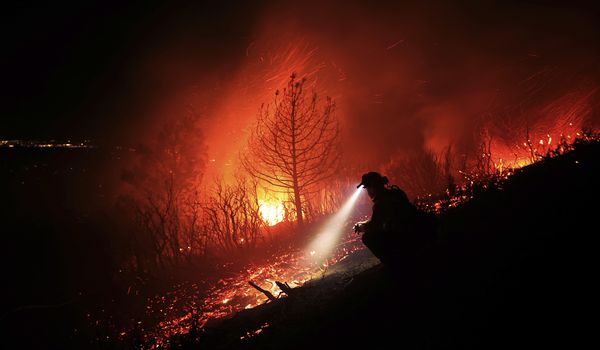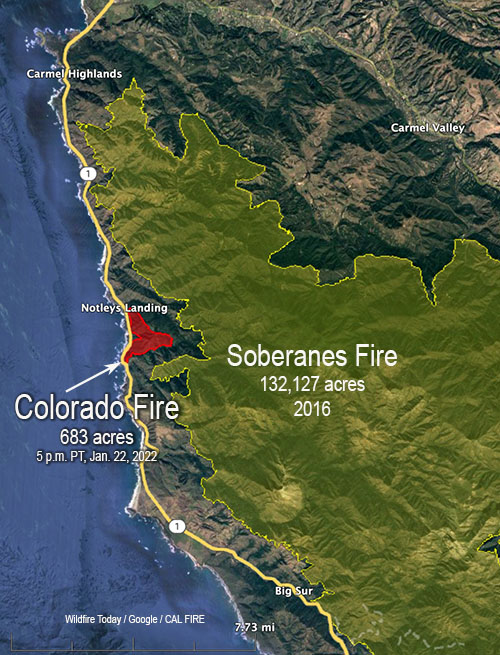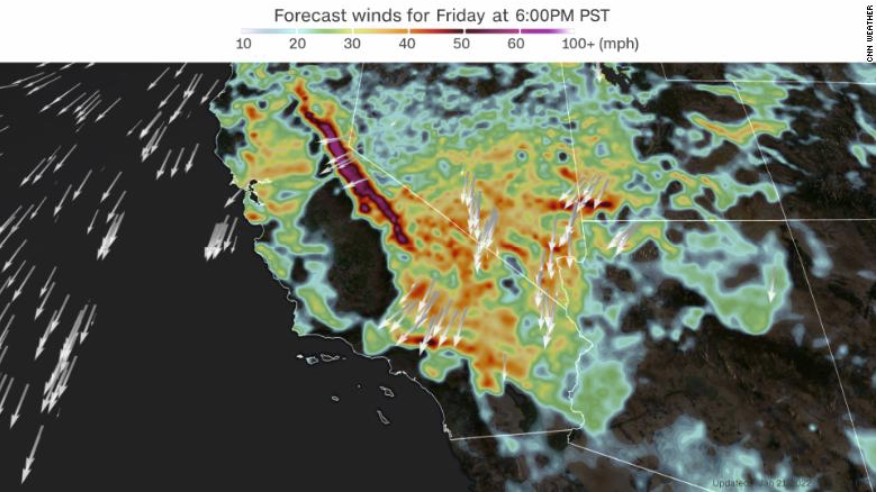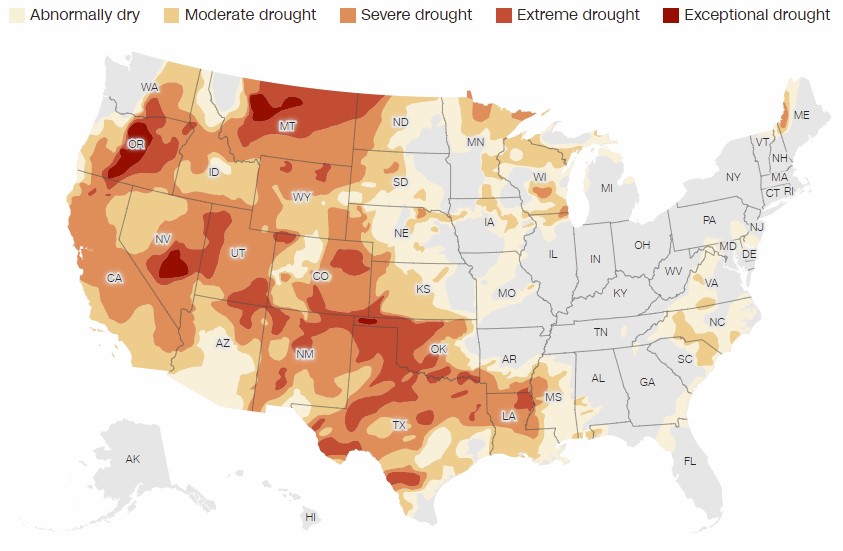
A fire burning in California shut down part of Highway 1 and forced evacuations. As of Saturday night, it had grown to 1,050 acres, and was 20% contained.
The blaze — called the Colorado Fire — began around 7:30 p.m. Friday near Palo Colorado Road in Big Sur, where it “remained stubbornly active overnight,” according to the National Weather Service.
By Saturday morning, the Colorado fire had grown to 1,500 acres, crossed Highway 1 and forced people from their homes. About 500 people had been told to evacuate.
A 1,500-acre fire near the coastal community of Big Sur, California triggered evacuations and closed part of a major highway, state and local officials said https://t.co/i9BIcjnQzZ pic.twitter.com/WSScYH9zw7
— Reuters (@Reuters) January 23, 2022
About 120 firefighters were battling the fire, which drew a large mutual aid response that included strike teams from multiple Cal Fire units. Two air tankers and two helicopters were attacking the blaze from the sky.

The fire is burning in the scar of the 2016 Soberanes fire. Unlike the Soberanes fire, which featured tall, rolling flames, the flame lengths of the Colorado fire are averaging only about three to four feet because there is nothing to carry the fire up into the trees.
Evacuation orders issued after a fire broke out along the Big Sur coast in California last night. The fire has burned 1,500 acres. pic.twitter.com/L9njmt13O2
— PM Breaking News (@PMBreakingNews) January 22, 2022
The weather agency said the fire began when offshore winds were gusting and there was very low humidity. On Saturday morning, wind gusts in Northern California approached 100 miles per hour in certain areas, prompting the NWS to issue wind advisories.
The California Highway Patrol closed Highway 1 at Rio Road just outside of Carmel-by-the-Sea due to the fire and there is no estimated time for reopening, officials said Saturday morning. From south of the fire, Highway 1 was closed at Andrew Molera State Park, just north of Big Sur.
BIG SUR FIRE UPDATE | Crews making progress against the #ColoradoFire in Big Sur. Cal Fire says containment is up to 20% with 1,500 acres burned. Air resources have arrived to battle the flames. pic.twitter.com/enkpQsZDqL
— KSBW Action News 8 (@ksbw) January 23, 2022
The American Red Cross opened a shelter late Friday evening for some residents who received mandatory evacuation orders due to the fire. The emergency shelter for residents of the Palo Colorado area of Monterey County opened at 11:30 p.m. at Carmel Middle School.
Smoke from the fire is forecast to head towards the Monterey Peninsula and Salinas, according to the NWS. Residents and firefighters in the area are urged to monitor light southward winds that could change the track of the fire’s spread.
So where will the smoke from the Colorado Fire most likely go today? Yesterday offshore winds pushed much of the smoke towards the ocean and south of Big Sur. A wind shift today will bring some of the smoke and haze towards the Monterey Peninsula and Salinas. #ColoradoFire pic.twitter.com/7VjWBKKUwb
— NWS Bay Area (@NWSBayArea) January 22, 2022
The weather agency points to California’s drought conditions as a possible reason for the unusual January fire. According to the National Integrated Drought Information System, more than half of the state is experiencing severe drought, which makes for longer fire seasons with “high burn intensity, dry fuels and large fire spatial extent.” In the area of the wildfire, rain is not forecast for the next seven days or so, according to the NWS.
“It seems as though the long term drought is acting like a chronic illness where even recent rains and cold winter wearther isn’t helping to keep fires from developing,” the NWS said.
Big Sur is on fire! ? #California #BigSur #BigSurFire pic.twitter.com/sA4eyjCwaT
— Jay Hunter Anson (@JHX_1138) January 23, 2022
Powerful Santa Ana winds; Widespread power outages
Powerful offshore winds knocked down trees and power lines around Southern California overnight while fanning brush fires in Big Sur and Sonoma County.
In Los Angeles County, where a high-wind warning was in effect until 3 p.m. Saturday, gusts of up to 89 mph were recorded at Mt. Lukens in the San Gabriel Mountains, said Mike Wofford, meteorologist with the National Weather Service in Oxnard.

Pictures shared on social media showed fallen power lines in foothill areas like Altadena. Toppled trees smashed into houses in Monrovia, Ontario and Upland, crushed cars in Claremont and blocked a portion of Pacific Coast Highway west of Heathercliff Road in Malibu.
Southern California Edison reported 92 outages affecting 24,554 customers in its service area as of 10 a.m. About 20,298 of those customers were in Los Angeles County.
As of 3:30 p.m., about 70,000 customers were experiencing wind-related outages, said media relations advisor Gabriela Ornelas.
The winds prompted the South Coast Air Quality Management District to issue a dust advisory that was in effect from noon Saturday through noon Sunday. The worst air quality was expected Saturday in the Inland Empire and Coachella valleys, regulators said.
Those in areas affected by high levels of windblown dust were advised to remain indoors with windows and doors closed, and to avoid vigorous physical activity.
Downed trees and power lines were also recorded across the Bay Area, including in Oakland and Berkeley. The Weather Service extended a high-wind warning for the North Bay mountains until 4 p.m. Sunday.
In Sonoma County, a gust of 96 mph was recorded at a weather station in Healdsburg Hills, to the east of Geyser Peak, where a brush fire broke out around 1 a.m. The fire was contained at about 1.4 acres several hours later. There was no word on its cause.
Unusual Big Sur Fire
It is very unusual to have a fire of this size in January so close to the coast in this area.
Although January fires are not unheard of in California, they are typically associated with a drier winter, whereas this one came after a series of wet storms, with fuel moistures in the area normal for January, Bingaman said.
More footage from last night of the #ColoradoFire burning in Big Sur right now. As of this morning the fire has burned 1500 acres, and is 5% contained pic.twitter.com/w5biNEnS0y
— Christopher Neely (@TopherJNeely) January 22, 2022
This fire is a little unusual given that we had the wet atmospheric river in October and then again in December.
It’s possible the long-term drought that continues to plague the region means that relatively recent rains and cooler winter weather are no longer sufficient to keep fires from growing.

Winds were expected to remain lighter in the area throughout the day Saturday, ranging from 5 to 10 mph with gusts of 12 to 15 mph, Bingaman said. The calmer conditions were helping the firefight. By Saturday night, the fire had shrunk to 1,050 acres and was 20% contained.
The Colorado Fire comes following promises from the Biden administration to address the country’s wildfire crisis. On Friday, Vice President Kamala Harris announced a $600 million federal investment towards helping California recover from last year’s wildfires. And just last week, the Department of Agriculture and U.S. Forest Service announced a 10-year multi-billion dollar initiative to prevent wildfires.
This is a good reminder that folks should continue to always be alert and prepared for the possibility of wildfires out West, especially when we are looking at offshore winds that can enhance them.
There’s no fire season anymore in California. It just doesn’t make sense anymore to call it a fire season when we get big fires like this year round. We really should calling it a fire year at this point. [LA Times, CBS News, CNN]
So always be prepared and ready to act! When cellular networks go down & internet access fails, Galileyo will keep you informed, via the global satellite infrastructure, guaranteed.
Now subscribe to this blog to get more amazing news curated just for you right in your inbox on a daily basis (here an example of our new newsletter).
You can also follow us on Facebook and/ or Twitter. And, by the way you can also make a donation through Paypal. Thank you!
You should really subscribe to QFiles. You will get very interesting information about strange events around the world.












